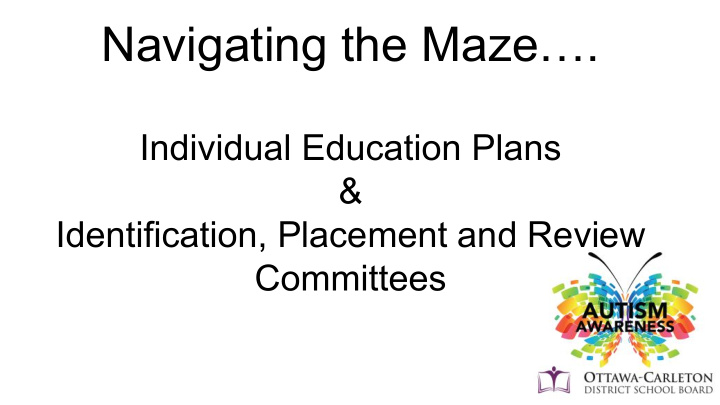



Navigating the Maze…. Individual Education Plans & Identification, Placement and Review Committees
Commonly Used Acronyms • Individual Education Plan (IEP) • Identification, Placement & Review Committee (IPRC) • Accommodations (AC) • Modifications (Mod) • Alternative (Alt)
Learning for All We are committed to Learning for All . We believe everyone can succeed in a culture of high expectations when we use instructional approaches including: •Differentiated Instruction (DI) to meet the needs of all learners through intentional, precise planning of assessment and instruction •Universal Design for Learning (UDL) to intentionally meet the needs of all learners •Tiered Intervention
Tiered Intervention Model Tier 1 Instruction and assessments for all students, planned in relation to the curriculum. The teacher observes, monitors student progress, and notes which students may be experiencing difficulty Tier 2 On the basis of assessment results, interventions are planned who are experiencing difficulty in a particular area or in general. Student progress in response to these interventions is closely monitored, and instruction is adjusted as needed Tier 3 For students who require additional support to achieve learning goals even more precise and intensive instruction and assessment are planned, often with the help of the in-school team and/or other available resources. Monitoring of progress continues.
What is an IEP? • A written plan describing the special education programs and/or services required by a particular student based on assessment of the student’s strengths and needs • A record of the particular accommodation(s) needed to help the student achieve learning expectations • A working document that identifies modified expectations or alternative learning expectations not represented in the Ontario Curriculum • A record of the specific knowledge and skills to be assessed and evaluated for the purpose of reporting student achievement
An IEP is not…... • A description of everything that will be taught to the student • A list of the teaching strategies used in regular classroom instruction • A record of all learning expectations, including those that are not modified from the regular grade level expectations • A daily lesson plan
Why/ When/ How/ Who Why: Growing evidence of need for special education supports and services When: Within 30 days of decision to implement IEP How: With principal support and parental consultation Who : Classroom teacher in collaboration with relevant staff members (e.g., LST, LRT, SLP, ELL, etc.)
A formal identification is not required to develop an I ndividual E ducation P lan
Development of an IEP • The student regularly requires accommodations for instructional or assessment purposes and/or • The school principal determines that a student’s achievement will be assessed on the basis of modified expectations and/or • The student requires alternative program expectations (i.e., self regulation, communication, social skills, daily living. etc…)
Accommodations & Modifications Accommodations: • Special teaching and assessment strategies and/or individual equipment required to enable a student to learn or demonstrate learning • They do not alter Ontario Curriculum expectations • May be instructional, environmental and/or assessment Modifications: • Expectations are changed from the grade level expectations in order to meet the student’s learning needs • May involve expectations at a different grade level and/or increasing or decreasing the number and complexity of expectations
Alternative Expectations • Expectations not reflected in the Ontario Curriculum • Communication, social skills, daily living programs • Assessed using the alternative report card • Ministry of Education developing an Alternative Curriculum Framework
Major Sections of the IEP
IPRCs • Process governed under Regulation 181/98 • Sets out specific timelines, responsibilities and appeal process
Purpose of an IPRC • To determine whether a student is exceptional • To identify strengths and needs • To identify the exceptionality • To recommend a placement • To review identification and placement of a pupil at least once each year • The committee consists of at least 3 people one of whom must be the school principal, supervisory officer or designate • Participants include: parents, student, school staff, professionals, parent’s representative
What is an Exceptional Pupil? • The Education Act defines an exceptional pupil as one: – Whose behavioural, communication, intellectual, physical, or multiple exceptionalities are such that he/she is considered to need placement in a special education program by a committee
Ministry Definition: Autism A severe learning disorder that is characterized by: a) disturbances in - rate of educational development - ability to relate to the environment - mobility - perception, speech, and language. b) lack of the representational symbolic behaviour that precedes language
When Does an IPRC Occur? 1. The school principal may initiate an IPRC upon written notice to the parent, Or 2. The school principal shall initiate an IPRC upon written request of a parent.
Placements & Programs Ministry Placement OCDSB Special Education Options : Programs : – Regular class with indirect – Regular Program support – Specialized Program – Regular class with resource assistance – Regular class with withdrawal assistance – Special education class with partial integration – Special education class full time
At the End of the IPRC • Formerly known as Determination Record • The committee will produce a Statement of Decision • Parental signature indicates agreement with the identification and placement decisions that have been made
Questions?
Recommend
More recommend